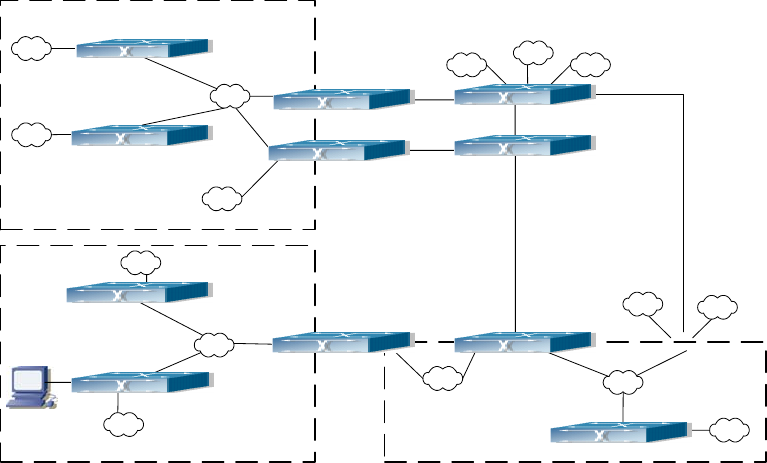
432
EES4710BD 10 Slots L2/L3/L4 Chassis Switch
Switch5(Config-if-vlan3)#exit
!Enable OSPF protocol, configure the number of the area in which interface vlan2 and vlan3
reside in.
Switch5(Config)#router ospf
Switch5(Config-router-ospf)#exit
Switch5(Config)#interface vlan 2
Switch5(Config-if-vlan2)#ip ospf enable area 0
Switch5(Config-if-vlan2)#exit
Switch5(Config)#interface vlan 3
Switch5(Config-if-vlan3)#ip ospf enable area 0
Switch5(Config-if-vlan3)#exit
Switch5(Config)#exit
Switch5#
Scenario 2: Typical OSPF protocol complex topology.
Domai n 2Domai n 3
Domai n 1
N3
N1
N8
N5
N6
N9
N10
N4
N2
N15
N14
N7
N12
N13N11
Domai n 0
SWI T CH1
SWI T CH2
SWI TCH3
SWI TCH4
SWI TCH5
SWI TCH6
SWI T CH9
SWITCH12
SWI TCH11 SWI T CH1 0
SWI TCH7
SWI TCH8
Fig 18-4 Typical complex OSPF autonomous system.
Figure 18-4 is a typical complex OSPF autonomous system network topology. Area1 include
network N1-N4 and layer 3 switch Switch1-Switch4, area2 include network N5-N7 and layer 3
switch Switch7, Switch8, Switch10 and Switch11, area3 include N8-N10, host H1 and layer 3
switch Switch9, Switch11 and Switch12, and network N8-N10 share a same summary route with
host H1(i.e., define area3 and a STUB area). Layer 3 switch Switch1, Switch2, Switch5, Switch6,
Switch8, Switch9, Switch12 are in-area layer 3 switches, Switch3, Switch4, Switch7, Switch10 and


















